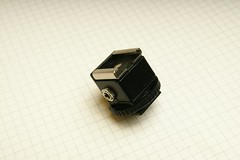There are broadly two types of meter. A reflective meter and an incident meter. Your camera comes with a reflective meter and what that does, is measure the tonality of light reflected from your subject. This meter will tell you what exposure settings to use to make whatever its pointed at look like a middle grey tone. When someone says to add a stop for Caucasian skin or subtract a stop for Black skin, they are referring to a reflective meter reading taken from the person's skin. A reflective meter will tell you how to get the tonality of former prime minister John Major but a white person will be too dark at that setting and a black person will be too light, hence the exposure compensation.
The other type of meter is an incident meter. An incident meter measures the light falling on your subject and it tells you what exposure to use to render your subject's true tonality. So you hold the meter close to your subject and point it at the camera. And the meter will tell you how to make a black cat look black or a Scottish lass look pale blue. Put them next to each other and provided the light falling on them is the same, they should both be properly exposed. I own a Sekonic L-308S
So hopefully that clears things up. With a reflective meter you have to adjust the exposure for the subject,but for an incident meter you don't need any compensation.
Seeing as most people use reflective meters, its worth explaining a little more about them. Reflective meters in cameras come in many different flavours these days. Centre weighted, matrix metering and and spot. Centre weighted and matrix metering are meters that look at the overall scene and give you an average value based on a number of factors. Centre weighted gives more priority to the centre of the image and matrix metering can be almost black magic on some cameras, consulting a database of scenes to determine an exposure based on a number of readings taken at different points. Determining how to compensate for these meter readings is really a matter of understanding the scene and getting a feel for how your meter on your camera behaves.
Spot metering on the other hand gives you a meter reading from a small spot in the centre of the image. So if you want to get a good exposure of black skin you might want to take a spot reading of just the skin and then do your -1 adjustment.
If your camera doesn't have a spot meter or the spot is too large to isolate the part of the scene you want to meter, here is a tip for you. If you have a zoom lens, you can zoom in on the part of the scene you want to meter. Or you could always swap for a longer lens, take your meter reading and swap back.
I hope you find this article useful and if it inspires you to buy a flashmeter, please consider getting one from the amazon links on this page. The commission I earn from the amazon affiliate links gets spent on books that I review here. If I can tell my wife that they are paid for by the blog she doesn't beat me.





